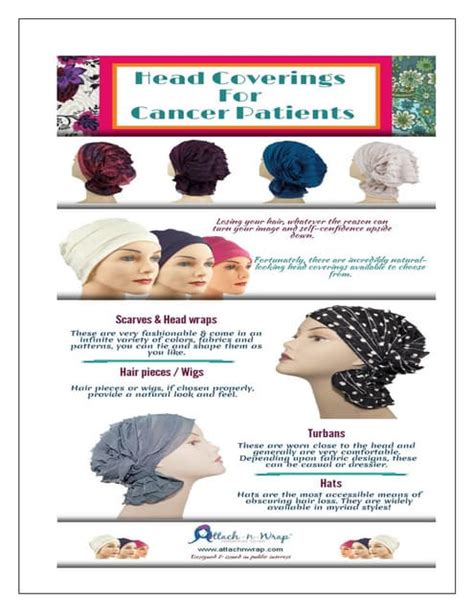Understanding the Needs of Cancer Patients
Cancer treatments, such as chemotherapy and radiation therapy, often cause hair loss. This can be a traumatic experience for patients, affecting their body image and self-esteem. However, head coverings offer a comfortable, stylish, and dignified solution to this common side effect.

Types of Head Coverings
There are numerous types of head coverings available for cancer patients, each with its own unique benefits. Here are some popular options:
Headscarves
Headscarves are a versatile and affordable choice. They come in various fabrics, colors, and patterns, allowing patients to express their personal style.
Beanies
Beanies are warm and cozy, making them ideal for colder months. They are also available in a wide range of styles and materials, from soft cotton to stylish faux fur.
Caps
Caps are another popular option, especially for those who prefer a more sporty or casual look. They are often made from breathable fabrics like cotton or linen, ensuring comfort during prolonged wear.
Turbans
Turbans are elegant and sophisticated head coverings that provide full coverage. They come in a variety of fabrics and designs, from simple cotton to intricate embellishments.
Hair Prostheses
Hair prostheses, also known as wigs, offer a realistic and natural-looking alternative to hair. They can be custom-made to match the patient’s natural hair color and texture.
Bandanas
Bandanas are a lightweight and convenient option, perfect for activities like yoga or running. They are often made from soft, absorbent fabrics to keep patients cool and comfortable.
Benefits of Head Coverings
Head coverings for cancer patients offer numerous benefits, including:
- Protection from the elements: Head coverings protect the scalp from the sun, cold, and wind.
- Enhanced comfort: They provide a soft and gentle barrier between the scalp and other surfaces, reducing friction and irritation.
- Improved self-esteem: Head coverings can help cancer patients feel more confident and less self-conscious about their appearance.
- Reduced anxiety: By providing a sense of privacy and protection, head coverings can reduce anxiety and stress levels.
Choosing the Right Head Covering
Choosing the right head covering depends on the individual patient’s needs and preferences. Consider the following factors:
- Size and shape: The head covering should fit comfortably on the head without being too tight or too loose.
- Material: Different materials offer different levels of comfort and breathability. Choose fabrics that are soft, breathable, and easy to care for.
- Style: Head coverings come in a wide range of styles, from simple to elaborate. Choose a style that matches the patient’s personal aesthetic and lifestyle.
- Purpose: Consider the intended use of the head covering. If it’s for everyday activities, choose a durable and comfortable option. For special occasions, a more formal or elegant style might be appropriate.
Where to Find Head Coverings
Head coverings for cancer patients are available through various channels:
- Hospitals and clinics: Many hospitals and cancer treatment centers provide head coverings free of charge or at a discounted price.
- Online retailers: Numerous online retailers specialize in head coverings for cancer patients, offering a wide selection of styles and sizes.
- Nonprofit organizations: Several nonprofit organizations, such as the American Cancer Society and Look Good Feel Better, provide head coverings to cancer patients in need.
Common Mistakes to Avoid
When choosing and using head coverings, avoid these common mistakes:
- Waiting until hair loss occurs: Start exploring head coverings before losing hair to ensure a smooth transition.
- Choosing the wrong size or style: Measure the head circumference and consult a professional for proper sizing and styling advice.
- Using harsh detergents: Hand-wash or use gentle detergents to preserve the fabric and prevent irritation.
- Overwashing: Excessive washing can damage the head covering and reduce its lifespan.
Pros and Cons of Different Head Covering Types
| Type | Pros | Cons |
|---|---|---|
| Headscarves | Versatile, affordable, stylish | Can be bulky or uncomfortable when tied tightly |
| Beanies | Warm, cozy, comfortable | Can be too warm for warmer climates |
| Caps | Breathable, casual, sporty | May not provide full coverage |
| Turbans | Elegant, sophisticated, full coverage | Can be expensive or difficult to style |
| Hair Prostheses | Natural-looking, versatile | Expensive, requires maintenance |
| Bandanas | Lightweight, convenient, absorbent | May not be suitable for formal occasions |
Conclusion
Head coverings are an essential tool for cancer patients, providing comfort, protection, and a sense of dignity. With a wide range of styles and materials available, patients can choose a head covering that meets their individual needs and preferences. By following these tips, cancer patients can find a head covering that helps them feel confident, beautiful, and supported throughout their journey.
